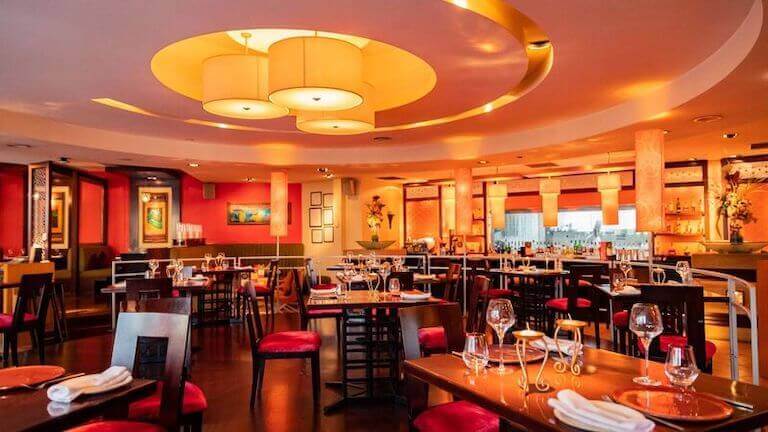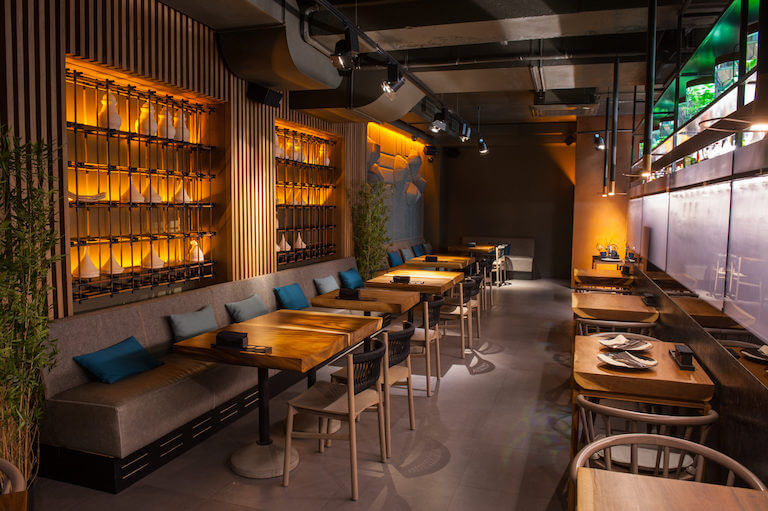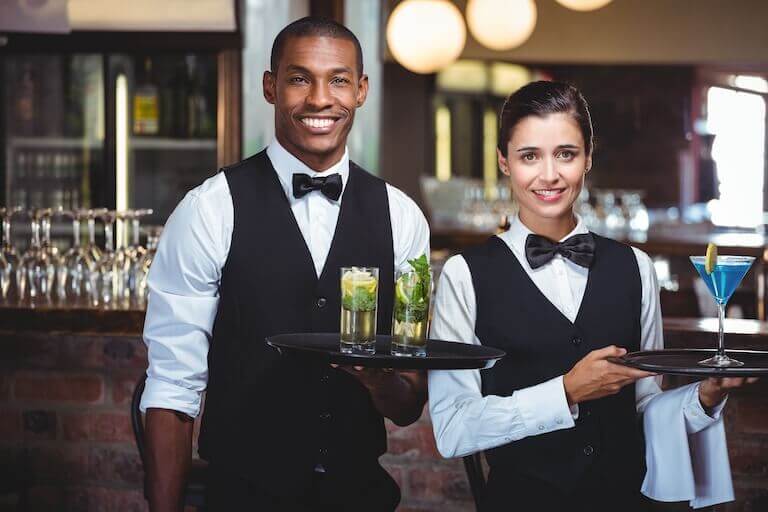Listen to This Article:
It’s safe to say that if food was the only draw to dining out, most of us would either cook at home or order takeout. But a good dining experience goes beyond what’s on the plate.
Just like a playlist at home will never replace the experience of a live concert—no matter how great the sound system—a home-cooked meal won’t replace the experience at a great restaurant. The difference comes down to atmosphere. Dinner with friends at home can be exceptionally fun, but the atmosphere at a restaurant is different.
When you create the right atmosphere at a restaurant, you pay attention to a variety of details that add up to how the entire experience is perceived; that atmosphere touches upon our five senses as well as our emotions in a unique combination.
5 Tools for Creating Your Restaurant’s Atmosphere
At your restaurant, a clear vision of the mood you’re after will inform your long-term operational and decorative decisions. Are you a casual, family-friendly space? An international restaurant seeking to deliver old-world charm? Or an upscale, special occasion restaurant? Each of these will call for a specific coordination of elements to achieve the right atmosphere.
Here are five of the most important factors to get right when establishing your restaurant’s atmosphere.
Set the Tone with Lighting
The lighting in your restaurant may be the first thing a diner notices when they walk through the door, and it goes a long way toward setting expectations. Your clientele may take note of whether the lights are bright or dim, the style of the fixtures, and the colors.
A restaurant will generally have ambient lighting, which affects the brightness of the space, accent lighting, which creates visual interest and may highlight spaces with visual interest, and task lighting, like that used at a hostess stand or in the kitchen.
Generally, casual and family-friendly restaurants use brighter lighting, while upscale and romantic restaurants tend to turn the lights down low. Many also have two “pre-set” lighting levels — a brighter setting for daytime, and a dimmer setting for the evening. In fact, research backs up the notion that people tend to prefer brighter lit spaces in the morning and dimmer lighting at night. Correct light levels are so important that it’s common to hide the controls under lock and key, so only the managers can change them.
Professional lighting designers can help restaurant owners establish the number and placement of fixtures to get the right lighting effect. But if that’s out of your budget, you can work with what you have. Swap out bright bulbs for dimmer ones with warmer colors, or add floor lamps or candles for a bit more light. You may also be able to install more sensitive dimmers to give you more control over light levels.
The lighting in your restaurant is more than a choice between bright and dim. It’s a combination of brightness as well as a spectrum of color “temperatures” that help set a mood—some light bulbs emit a warm glow while others are considered cool.
The color temperature scale uses degrees of kelvin on a scale of 1,000 to 10,000, denoted by a capital K after the number. Higher numbers represent cooler temps, while lower numbers represent warmer temps. Daylight is about 5200K, while anything less than 2000K is dim and yellowish, similar to candlelight, and anything above 6500K is considered bright and bluish.
Choosing the Right Color Temperature for Your Restaurant’s Lighting
Here are some suggested light bulb ranges for various scenarios:
- For a quiet, cozy vibe: 2700K
- For a neutral white: 3100K-4500K
- To mimic daylight or for the brightness needed in a space like a commercial kitchen: anything above 4500K

The style of light fixtures as well as the brightness each contribute to your restaurant’s atmosphere.
More Than Comfort: Send a Message With Furniture
Seating and furniture layout are another major factor in a restaurant’s atmosphere, even if the guests aren’t as aware of it. Rows of 2-tops will indicate that this is a place for date night. Long communal tables say this is a place to gather with friends. Seating for groups of four to six could mean the restaurant is family-friendly—or, when combined with low lighting and high-end furnishings, it could be a perfect place for swanky business dinners.

Your choice of furniture and layout are key components of your restaurant’s atmosphere.
You want to strike the right balance between accessibility for staff and patrons with the tone you’re looking to set, plus ensuring you have the right number of seats to turn a profit, per your business plan.
Beyond the layout, there are furniture design factors as well. Dark, heavy furniture is often associated with traditional upscale restaurants, like steak houses. Lighter furniture in both weight and color may show that a restaurant is more casual, like a family eatery or cafe.
Coordinate the Decor
There are as many styles of restaurant decor as there are types of food. And it’s the area where having a clear vision for your restaurant’s atmosphere may be the most vital. It’s easy to see something you like and pick it up for the restaurant. But you have to know where each piece fits into the overarching mood.
Hard Rock Café, for example, built on its musical theme by bedecking its walls in rock-and-roll memorabilia.
A restaurant that wants to create a hyper-local atmosphere may want to display art by area artists. A Provençal-style restaurant may want to bring in antiques and decorate with fresh lavender to evoke southern France. The possibilities are endless.
Signage is another important part of decor, from your street-facing sign to the basic safety or instructional signs within your restaurant. Invest in attractive, on-brand signs instead of relying on flimsy printouts that get dirty or torn.
If you don’t have the “designer’s eye,” reach out to your network to see if you know anyone who can help. Auguste Escoffier School of Culinary Arts graduates have access to the Escoffier Alumni Association, making it easy to keep in touch with former classmates and ask their advice.
Adjust Music and Sound for the Right Mood
Because restaurants tend to be large, open spaces with lots of hard surfaces, noise and echoes can be amplified. This can make a dining room of 150 sound like a stadium of 5,000!
Minimize echoes with rugs, upholstered furniture, curtains, and soundproofing panels on the ceilings and walls. This may require an up-front investment, but noise levels are one of the most frequent complaints among restaurant guests.
Once you’ve got the noise level under control, what kind of music will you bring to your restaurant?
That Provençal restaurant from earlier just needs a little French guitar jazz to complete the mood. A western-style restaurant may want to play country music. But make sure to get specific. Country is a wide genre, so make sure you understand what genre and era of music is right for your restaurant. Same for any sub-genre of music you choose. You don’t want to aim for relaxing instrumental and wind up sounding like a doctor’s waiting room, for example.
Finally, consider this—fast music may encourage people to eat more quickly. So if speed and turnover is an important part of your service plan, keep those beats per minute up. On the other hand, if you only need to turn each table twice per night, play slower music to encourage your guests to savor and relax.
Make sure you also have proper licensing in place to play music in your restaurant, or you could be subject to big fines by the music publishing companies!
Set Expectations for Staff-and-Guest Interactions
A professional and respectful demeanor is just the start for restaurant employees. Beyond that, it’s important for you to define how, specifically, you would like your restaurant staff to interact with guests.
At some restaurants, servers are experts about menu and drink choices and can suggest pairings, but they are expected to remain at a distance from guests. At other restaurants, servers may be more interactive and chatty with guests, even entertaining. There’s a wide range of roles, from Disney characters and singing waiters to stiff upper lip, white glove service.
Remember, too, that uniforms help augment the tone. Your employees should have a distinct and consistent look, with outfits that reflect the messaging you want to send.
This interaction between staff and guests is part of your restaurant’s ambience, and it’s up to you as manager or owner to spell out the ground rules for your staff. You don’t want a server to inadvertently make guests uncomfortable with too much chit-chat—or on the flip side, leave guests wishing the wait staff had been friendlier.

Your restaurant staff’s uniforms help set the tone for the type of experience and ambience your restaurant delivers.
Find Out More About Hospitality & Restaurant Management
Atmosphere is the product of dozens of little touches, and restaurant owners need to make sure each element is working together to create the right vibe. Great vibes and positive customer experiences are key components of good hospitality.
If you’d like to find out more about culinary entrepreneurship, then a degree or diploma in Hospitality & Restaurant Operations Management from Auguste Escoffier School of Culinary Arts may be a great place to start. Get more information on all of our programs today!
TO FIND OUT MORE ABOUT RUNNING A RESTAURANT, TRY THESE NEXT:
- Restaurant Franchising: A Brief Guide and Opportunities
- How to Start a Restaurant: a Step-by-Step Guide
- How to Transition Your Food Truck to a Restaurant
This article was originally published on April 18, 2016 and has since been updated.


